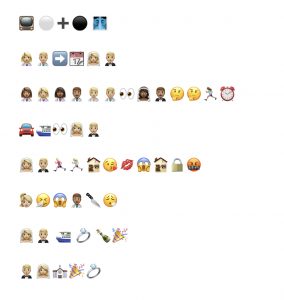Emoji story:

First of all, I found this task very challenging and I will be amazed if anyone is able to guess what show and episode my emoji story depicts. My emoji story represents the most recent episode of a show I’m watching, and it was not chosen based on the ease of visualization. I am eager to hear your guesses!
This task was a lot harder than I expected and I ended up focusing on key ideas only, rather than trying to capture details, which I found couldn’t be ‘correctly conveyed’ with a limited set of emojis. The show I am watching has an immense amount of details – it involves live-action scenes, backgrounds, established characters, and I often couldn’t find the ‘right’ emoji to capture all of these details. We are limited by those who create emojis and while in my day-to-day usage I normally find the range of emojis to be quite broad, for this task there were certain details such as a light-skinned character with brown or red hair, that were not included in the emoji keyboard.
Another challenge was related to the fact that each emoji can have several meanings. I kept flip flopping between using emojis to convey their literal meaning versus their symbolic meaning. This is consistent with Bolter’s (2001) argument around each element in picture writing meaning too much than too little and having different meanings. This makes it challenging for any ‘reader’ or ‘viewer’ of my emoji story to understand what is being conveyed. An emoji’s meaning is also dependent on the creator and viewer’s context and culture – for example, the diamond ring emoji, which is meant to symbolize a wedding that took place in the show, may not convey the same meaning for a different viewer.
I used my iPhone’s Notes application to capture my emoji story and in doing so, it seems like text is still in control, despite not using any text in my story. Bolter (2001) discusses the tension between textual and visual forms of communication and while this entire task is made up of graphics (emojis in this case), they are used in a textual way. The emojis are organized as if in sentences and I used spaces between the lines of emojis, as if I was organizing paragraphs to separate ideas.
Prior to this task, I have never used emojis alone to tell a story; they have only been used as ‘decorative pieces’ to supplement text. It is interesting to think that emojis alone or text alone are both open to several interpretations – emojis alone can carry different meanings and text alone requires a reader to make several inferences or visualizations. However, when put and used together, they can help provide more contextualisation, resulting in less interpretation.
If visual forms of communications, including emojis, can help to enhance communication, it is surprising to me that emojis haven’t made their way into ‘professional’ or ‘business’ writing. When writing emails, it seems taboo to include emojis as they are deemed as ‘unprofessional’ but why is this, if they can enhance our communication?
Reference
Bolter, J. D. (2001). Writing space: Computers, hypertext, and the remediation of print (2nd ed). Lawrence Erlbaum Associates.
Hi Shannon!
I think it’s a Grey’s Anatomy episode but I don’t watch the show so I don’t have enough knowledge to drill down from there! I also used line breaks to provide some structure and formatting. I will say, I do wind up using emoji in my communication at work but it does vary on the venue – MS Teams is a free-for-all, while email is much more reserved. I think that’s due to the more immediate and casual nature of MS Teams chats for me….
You got it!! I was hopeful that the literal black + white equation would make sense to others.
Hi Shannon, first of all, thank you acknowledging this is a challenging task! I found this seemingly easy task super difficult as well. Honestly, I could not figure out which show this episode belongs to. I even tried to google a few things I thought relevant based on your emojis, but I could not find anything. Your focus on key ideas rather than details was a smart approach given the limitations of emojis. The range of emojis, while broad for everyday use, does fall short in capturing specific character traits and intricate details of scenes, as you mentioned.
I also found balancing literal and symbolic meanings using emojis can be tricky. Your reference to Bolter’s (2001) argument is spot on – the richness of each emoji’s meaning can both enhance and complicate communication. Context and cultural differences of both the writer and reader can influence interpretation.
Your comment on using emoji in professional settings is interesting. It’s indeed curious why emojis haven’t become more accepted despite their potential to enhance communication. Actually, I use emojis a lot in my Zoom chats with my colleagues at work. I am grateful for it, as it portrays my tone better and enhances our relationship at work. This is particularly useful to me as I work remotely full-time. Perhaps the perception of professionalism needs to evolve to embrace these modern forms of expression. After all, if they can improve clarity and engagement, there’s a strong case for their inclusion in professional communication.
Thanks for sharing your experience! It’s given me a lot to think about regarding the role and potential of emojis in our communication.